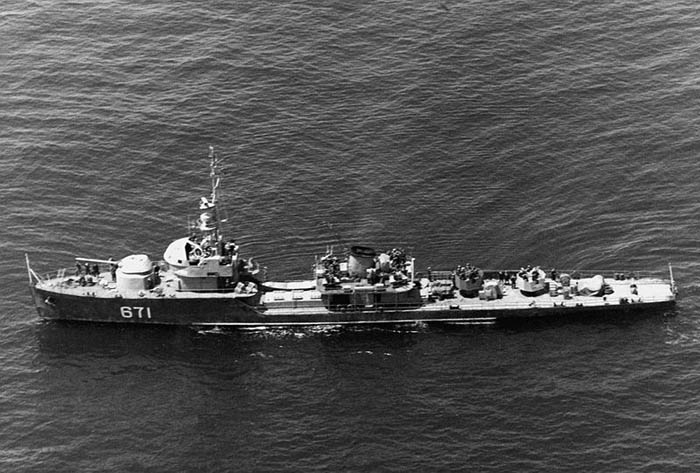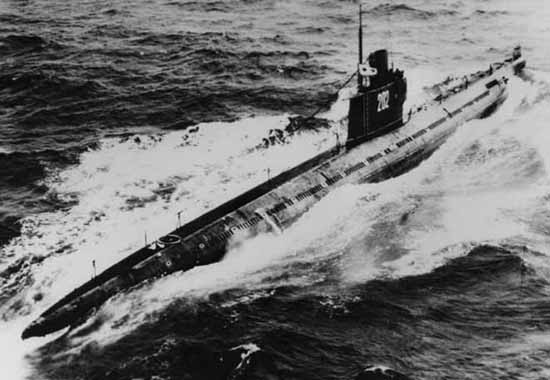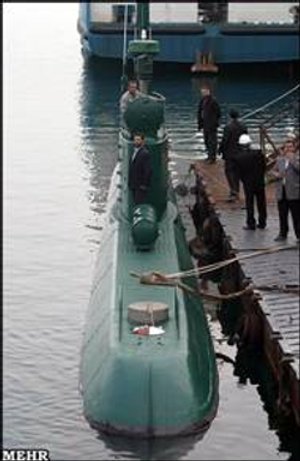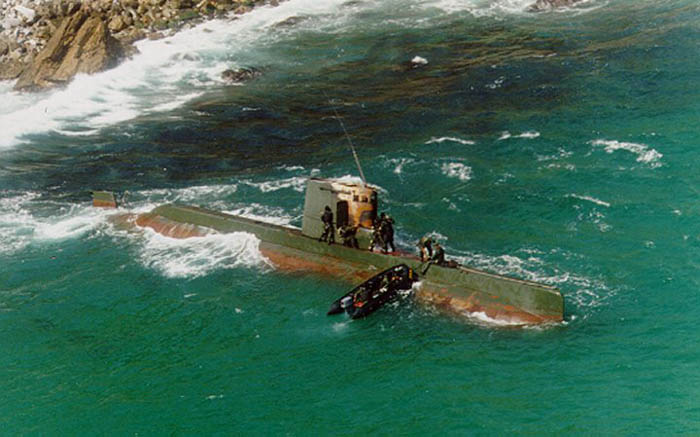A Complete History of the North Korean Navy
North Korean Submarines Must Be Considered A Threat To The U.S. And the Sinking of the South Korean Ship
Page 1 of 2
The navy of North Korea was established on June 5, 1946. The Navy strength in the 1990s was about 40,000 to 60,000; current strength is about 46,000. There are some 708 vessels including 3 frigates and 70 submarines: approximately 20 Romeo class submarines(1,800 tons), 40 Sang-O class submarines (300 tons) and 10 midget submarines including the Yono class submarine (130 tons). Numbers of subs listed are from the Defense Intelligence Agency. Most N. Korea vessels are small patrol - size craft unable to operate over 50 nautical miles from the coast but capable of policing the N. Korean territorial waters. The most capable weapons systems are the approximately 43 guided-missile patrol boats equipped with anti-ship missiles. The N. Korean Navy has OSA-1 guided missile patrol boats, 10 versions of the OSA-1, and 19 other fast-attack missile craft; all equipped with four missile launchers. The missiles have a maximum range of 25 nm and carry radar or infrared homing seekers. The largest part of the NKN consist of small combatants, including torpedo boats, patrol boats, fast attack craft, and small amphibious landing craft. Of the approximately 200 torpedo boats, nearly all are built in N. Korea. Most all are equipped 25mm to 37mm guns. There are at least 62 fire support units. These vessels have multiple rocket launchers in the center of its deck to provide fire support to ground troops or attack surface ships. Their attack submarine inventory is estimated to include 4 former Soviet WHISKEY class, 22 Chinese ROMEO Class submarines. The WHISKEY subs were acquired in the 1960s, and can carry 12 torpedoes or 24 mines. Shortly after delivering four ROMEOs in the early 1970s, China helped the NKN start its own ROMEO construction program. These subs are well equipped with improved sonar, and can carry 14 torpedoes or 28 mines. To date, the NKN has indigenously produced over 200 landing craft. This includes approximately 100 personnel landing craft based on a former Soviet P-6 torpedo boat hull. The craft has a maximum speed of 40 knots, each carrying up to 30 troops with a basic combat load. Amphibious craft include 8 medium landing ships, which can carry 3 to 4 light tanks, and 125 amphibious hovercraft. The NKN has a credible mine warfare capability. There are numerous small surface ships that are capable of delivering mines within both the Navy and civilian sectors. Mines will be used to defend against amphibious assaults, defend strategic ports, and provide seaward flank protection for land forces. Defensive mine fields will be monitored by coastal observation teams and radar. They will be supported by artillery and missile batteries. This will make close approach and mine clearing operations extremely hazardous. The NKN has a large inventory of older technology mines, experience with their effectiveness, and the willingness to use them.
Be advised that any and all reports concerning information on the N. Korean Navy is only approximate. Any information on the N. Korean military, especially the Navy, is the most secretive of any country in the world. Military equipment in large amounts is available from Russia and China. Spare parts and technological help are available, with China even supervising the construction of a plant for N. Korea to manufacture their own submarines. After observing many lists of names and numbers of submarines, how many in service, modifications, location, etc. it was obvious of the difference in reports. The following reports are as accurate as possible and may differ with numerous other reports. Remember that some subs built by N. Korea may use Russian technology which is based on German submarines from 1945. Also, parts including complete submarines are available from China and Russia.
An incident between a Chinese submarine and the U.S. Navy has caused the U.S. to take another look at our capability using old technology. A state-of-the-art Chinese Song Class submarine sailed within torpedo range of the U.S. Super Carrier USS KITTY HAWK during U.S. Naval exercises off the Chinese coast. U.S. Navy brass was completely outsmarted by the incident. The USS KITTY HAWK, 1,000 Ft. Super Carrier carried 4,500 personnel. The U.S. had no idea China's fast growing submarine fleet had reached such a level of sophistication, or that it posed such a threat. Our defensive screen, which included two U.S. submarines, was apparently unable to detect it. The Chinese submarine slipped past at least a dozen U.S. warships which were supposed to protect the carrier from hostile aircraft and submarines. The Chinese fleet includes at least two nuclear-missile launching vessels. The 13 Song class submarines are extremely quiet and difficult to detect when running on electric motors.
Two ships are examples of the growing Chinese threat are the Chinese T-Class ship, and the Ming Class submarine. There are no reliable figures on these two vessels, and we do not really know how many remain in service, or how many have been transferred to N. Korea. Both can cause us big problems, especially with the addition of nuclear missile launchers.
N. Korea is controlled by a hereditary dictatorship, ineptly run by Kim Jong-il. N. Korea is an impoverished country needing international aid to keep it's population from starving. Their situation is dire, as virtually every cent they have is spent on military equipment in hopes of causing WWIII. This article covers only the N. Korean Navy capability, and inventory. After the unnecessary Korean war of 1950, the country was completely destroyed by our constant aerial bombardment. N. Korea's arrogance has increased significantly since they won the war. Actually, the 200,000 Chinese troops and swarms of Russian Mig-15s assured their victory. That was 60 years ago, and since then nothing has changed except their country has continued to deteriorate. Where this will end up will be determined by Kim Jong-il, who is not only physically sick, but very short on intelligence.
In reading this report there are two things you will notice: N. Korea seems to have a formidable Navy not to be taken lightly. However another look exposes the fact that everything they have is really aging and outdated. We must remember that a shot fired by a Civil War gun will kill you as quickly as one fired from one of today's weapons.
Korean People's Navy Inventory
Warnings
It may be well to consider that other countries may be catching up with us, along with using different attack techniques. Chinese and N. Korean plans are to immediately destroy our carriers with a swarm of missile boats and submarines, along with the reported Russian development of "one bomb one carrier". The main problem as I see it is the lack of a "will to win" on our part. We lost the war in Korea in 1950 along with 36,913 men. We accomplished nothing in that war, ending up where it began. Vietnam was another large catastrophe that was an embarrassment for the U.S. costing us 58,202 men. We fabricated a reason to get into the war with Iraq, and the so called war in Afghanistan that has been going on longer than WWII. Lurking in the future are major confrontations with N. Korea again, and Iran. God forbid a disagreement with China. How many wars can the U.S. handle at a time when we are not only short on equipment, but personnel.
The Chinese Submarine Incident

N. Korean Navy T-Class

| ROMEO CLASS SUBMARINE | |
| Displacement: | 1,830 tons |
| Length: | 251 ft 3 in. |
| Propulsion: | Two diesels delivering 4,000 shaft horsepower with two electric motors driving two shafts. |
| Speed: | 15.2 knots surfaced, 13 knots submerged. |
| Range: | 9,000 miles at 9 knots. |
| Crew: | 54 men ( 10 officers). |
| Armament: | Eight 21 in. torpedo tubes. Six located in the bow and two in the stern. 14 (21 in.) anti ship or anti submarine torpedoes or 28 mines. |
North Korea operates 22 Romeo class submarines that were locally made with Chinese supplied parts and directly imported from China. The 4 Chinese imported units are based on the western front. It may be well to mention the fact that all of the figures of N. Koreas submarines continue to change as they now have their own construction capability, and can receive parts from China thus prolonging the life of existing submarines.

Whiskey Twin Cylinder Submarine
In the 1950s and 1960s some Whiskey submarines were converted to guided missile boats. These boats had the capability to fire one to four cruise missiles. In 1956 the first prototype was ready. It was a regular Whiskey-class submarine which was fitted with a launch tube aft that contained a single anti-ship missile. This vessel was known in the west as a Whiskey Single Cylinder. Between 1958 and 1960, six additional Whiskey-class submarines were converted to carry guided missiles. These boats had two missile tubes and were known as the Whiskey Twin Cylinder. Between 1960 and 1963, six boats received modifications that could contain four missiles. All guided missile variants had to surface to fire their missiles. The patrol variants were replaced by Romeo-class submarines. The guided missile variants were replaced by Juliet-class submarines.
| WHISKEY TWIN CYLINDER SUBMARINE | |
| Displacement: | About 1,350 tons. |
| Length: | 249 ft 4 in. |
| Propulsion: | Diesel-electric |
| Speed: | 18.5 knots surfaced. |
| Range: | 13,500 nmi surfaced |

YONO CLASS MIDGET SUB wiki
The Yono class submarine is a class of N. Korean miniature submarines, produced for domestic use and export. These submarines displace 130 tons, significantly less than N. Korea's larger 1,800-ton Romeo class submarine. As of May 2010, N. Korea is reported to operate 10 of these submarines. Iran has purchased several of these submarines from N. Korea
| Sang-O Class N. Korean Submarine | |
| Propulsion: | Diesel engine. |
| Armament: | two 21 in. torpedo tubes. |
A Yono class submarine is thought to have fired the torpedo which sank the South Korean Pohang-Class Corvette, the Cheonan, on March 26, 2010 in South Korean waters. The weapon used was a N. Korean manufactured CHT-02D torpedo, of which substantial parts were recovered. The device exploded not by contact, but by proximity, creating a powerful pillar of water called "the bubble jet effect".

Sang-O Class N. Korean Submarine
The SANG-O class submarines are currently in use by N. Korea, and are the country's largest home built submarines. This class is based on the Yugoslavian Heroj class submarines. They have been stripped down and have vintage radar and sonar.
The SANG-O was preceded by the Yugo class. There are reportedly 32 boats active as of August 2006.
| SANG-O CLASS N. KOREAN SUBMARINE | |
| Displacement: | 370 tons |
| Length: | 34m |
| Propulsion: | Diesel-electric |
| Range: | 1,500 nautical miles |
| Crew: | 25 |
| Sensors: | Radar and Sonar |
| Armament: | two 21 inch torpedo tubes fitted with Russian torpedoes. Capable of minelaying. |


